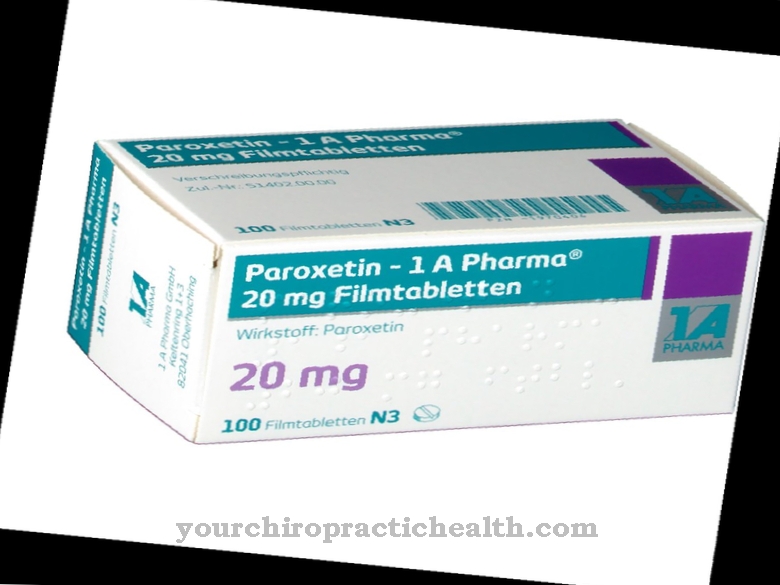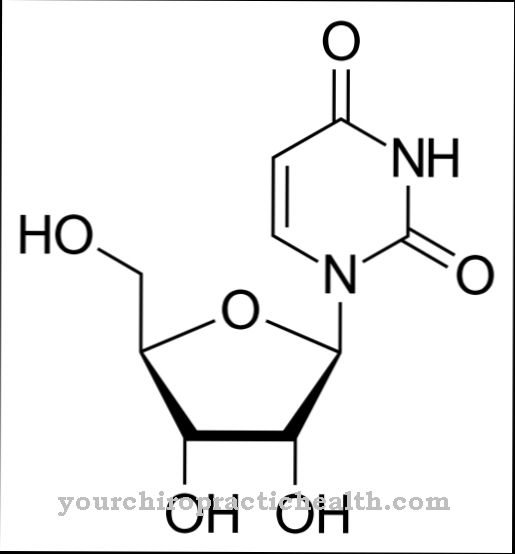The messenger substance Acetylcholine plays an important role within the human body, as it is used in numerous processes in the central nervous system as well as in the vegetative nervous system. In the therapy of Alzheimer's patients, preparations are used that have an indirect influence on the active ingredient by inhibiting the enzyme that is responsible for its breakdown. As a direct active ingredient, acetylcholine is used in ophthalmology for surgical interventions on the eye. This is the case when rapid constriction of the pupil is necessary for the procedure.
What is acetylcholine?

Acetylcholine is one of the most important neurotransmitters in the human organism. This active ingredient is a quaternary ammonium compound that was discovered in 1921 to function as a neurotransmitter.
The pharmacologist Otto Loewi had experimented with frog hearts and discovered that the heart rate is not controlled solely by electrical transmission. Because the fluid from the area around the heart of any frog had stimulated the heartbeat of any other frog as well. When he was looking for the reason for this, he came across the neurotransmitter.
This was initially referred to as vagus substance. Henry Hallett Dale, who had also worked on the chemical transmission of nerve impulses, later defined the active ingredient as acetylcholine. For their basic research, Dale and Loewi were jointly awarded the Nobel Prize for Medicine in 1936.
Pharmacological effect
Acetylcholine plays a key role in the motor endplate, where states of excitement are transmitted from the nerve fiber to the adjacent muscle fiber. In addition, the active ingredient ensures the transmission of stimuli between the nerve cells of the autonomic nervous system.
Acetylcholine occurs in both the sympathetic and the parasympathetic nervous system. The active ingredient also plays an important role as a transmitter in the central nervous system.
Cognitive processes, for example, only work properly if there is a sufficiently high concentration of acetylcholine. This becomes clear, for example, with Alzheimer's disease. This neurodegenerative disease, which mainly affects older patients, is associated with the death of nerve cells that produce acetylcholine.
Alzheimer's therapy attempts to counteract this acetylcholine deficiency by administering acetylcholine esters. This prevents this enzyme from breaking down acetylcholine into acetic acid and choline. Because acetylcholine acts on a wide variety of receptors, including those that are stimulated by nicotine, it is believed that acetylcholine is also important for learning and driving. However, evidence from empirical studies is still missing here.
Medical application & use
Acetylcholine is administered exclusively in ophthalmology, among other things to narrow the enlarged pupil again after operations. Basically, the active ingredient is used when operations are carried out on the front section of the eyes and this requires rapid and complete constriction of the pupil. Physiologically, the constriction is triggered by the vegetative nervous system, provided that sufficiently strong light impulses hit the eye.
Another area of application are so-called cataract operations on the eye. This term is popularly known as cataracts because an advanced cataract shows a gray color behind the pupil. Every year around 650,000 operations are performed in Germany in which the clouded lens is replaced by an artificial implant. These operations are among the most common surgical interventions on the eye.
One of the characteristic symptoms of cataracts is the slow and painless loss of visual acuity. In addition, the affected patients see a lot of things only blurred and suffer from an increasing sensitivity to glare. This results from the fact that the light is refracted very diffusely by the opacity. Acetylcholine is also used in what is known as irid ketomy. During this procedure, a puncture is made at the edge of the cornea, through which adhesions can be removed.
You can find your medication here
➔ Medicines against memory disorders and forgetfulnessRisks & side effects
Acetylcholine does not have any direct side effects. However, because of its pupil-constricting effect, among other things, it must not be contained in cosmetic products. This is stated in the EU directive on cosmetic products, which was passed in 1976.












.jpg)



.jpg)










.jpg)
